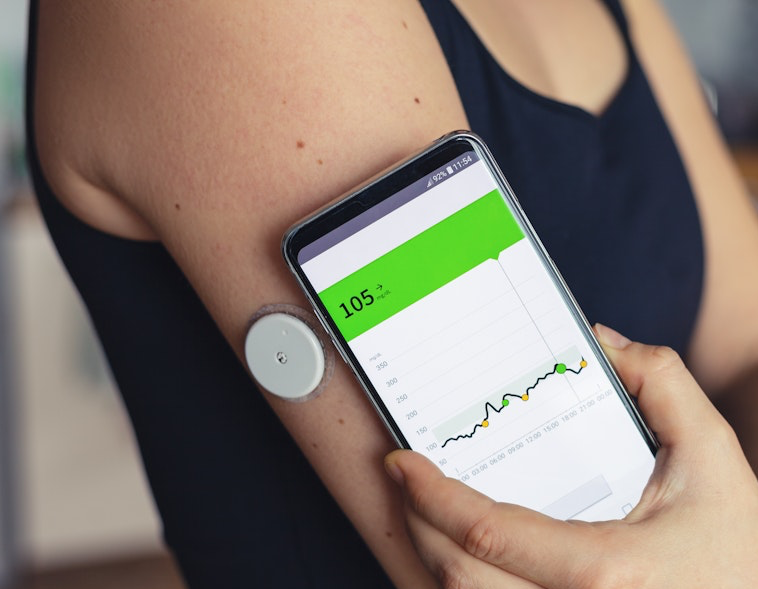Continuous Glucose Monitors (CGM)
In the last few years relatively cheap and convenient technologies have made consumer level devices available to continually measure the levels of glucose in the body. These devices measure the levels of glucose in the fluid between the cells (interstitial fluid), which reflect blood glucose levels, which is adequate for most purposes.
 The CGM devices consist of a fine sensor needle that penetrates the skin, a reading and transmission device and a waterproof cover. The commonest makes of sensor are between 20 and 35 mm in diameter and 3 and 5 mm thick. They are usually applied to the back or side of the forearm. The sensor needle penetrates about 5 mm but is very fine and insertion causes little more discomfort than a finger prick blood test.
The CGM devices consist of a fine sensor needle that penetrates the skin, a reading and transmission device and a waterproof cover. The commonest makes of sensor are between 20 and 35 mm in diameter and 3 and 5 mm thick. They are usually applied to the back or side of the forearm. The sensor needle penetrates about 5 mm but is very fine and insertion causes little more discomfort than a finger prick blood test.
When first released CGM devices were expensive, in short supply and required a dedicated reading device. They are now readily available, so essential users such as Type 1 diabetics can obtain all the supplies they need, the price has come down and most can be read using smartphone apps as well as a reading device. This has made it more acceptable for people with insulin resistance or other dietary issues to use them to gain insight into how different foods and eating patterns affect their blood glucose levels.
 The sensors are available without prescription in the UK and Europe, but prescriptions are needed in some other countries. The sensors last for between 10 and 14 days and at around £60 each that makes them quite expensive. However with intermittent use and maximising their benefits, they can be very helpful for some people to see what changes they should make to their diet and monitor the effectiveness after a period of time. They give a more reliable and consistent picture than finger-prick tests at intervals during the day.
The sensors are available without prescription in the UK and Europe, but prescriptions are needed in some other countries. The sensors last for between 10 and 14 days and at around £60 each that makes them quite expensive. However with intermittent use and maximising their benefits, they can be very helpful for some people to see what changes they should make to their diet and monitor the effectiveness after a period of time. They give a more reliable and consistent picture than finger-prick tests at intervals during the day.

The newer sensors sent out real-time data to automatically update a smartphone app or monitor, while some of the older models cache the data until the device is manually synchronised with the app at intervals. The sensors and apps by themselves are pretty stand-alone, and data can be exported and charted and analysed, but there are services that offer interpretation of results and appropriate dietary and nutritional advice based on the data collected. Lots of people simply take photos of all food and drink they consume and this allows them to correlate changes in blood glucose levels with their food intake.
 Anecdotally people find the insights gained very useful and in some cases shocking. The ones I have heard most often are: how much and for how long the “healthy breakfast” of oats porridge pushes up the blood sugar levels, and surprise at how much higher the levels go after eating rice over potatoes and pasta. The responses seem very individual however, and this seems to be where the CGM comes into its own, as it enables people to see what is not working for them and then whether any changes make a difference.
Anecdotally people find the insights gained very useful and in some cases shocking. The ones I have heard most often are: how much and for how long the “healthy breakfast” of oats porridge pushes up the blood sugar levels, and surprise at how much higher the levels go after eating rice over potatoes and pasta. The responses seem very individual however, and this seems to be where the CGM comes into its own, as it enables people to see what is not working for them and then whether any changes make a difference.
Twitter post
The basic and higher specification sensors from the two main manufacturers marketing in the UK are:

Abbott FreeStyle Libre 2 Continuous Glucose Monitors
5mm in height and 35mm in diameter - 14 day duration
https://www.freestyle.abbott/uk-en/products/freestyle-libre-2.html
Amazon £46.70
Abbott FreeStyle Libre 3 Continuous Glucose Monitors
2.9mm in height and 21mm in diameter - 14 day duration
https://www.freestyle.abbott/uk-en/products/freestyle-libre-3.html
Amazon £58.99
Dexcom one+
10 day duration
https://www.dexcom.com/en-GB/dexcom-one-plus-cgm-system
Dexcom shop £42.00
Dexcom G7 Continuous Glucose Monitors
4.7mm in height and 27mm in diameter - 10 day duration
https://www.dexcom.com/g7-cgm-system
Dexcom shop £61.50
Further Reading:
There is a good review of these products and the Nutrisense plan from WIRED:
https://www.wired.com/gallery/the-best-continuous-glucose-monitors/
The always excellent Lily Nicols wrote a good blog post: CGM Experiment What I learned as a non-diabetic from a continuous glucose monitor.
https://lilynicholsrdn.com/cgm-experiment-non-diabetic-continuous-glucose-monitor/
Contact me

 What is a Low Carb Diet
What is a Low Carb Diet